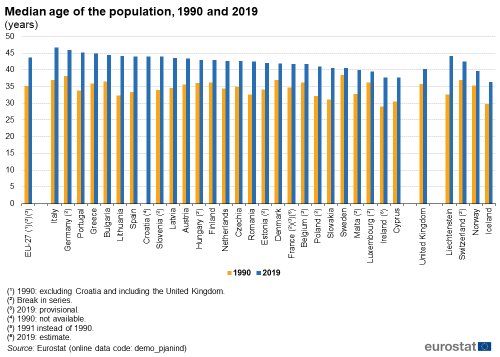Archive:Being young in Europe today - demographic trends
This article has been archived. For updated articles on youth, please visit the [Youth section]in Statistics Explained.
Highlights
Less than one third of the EU-27 population was under the age of 30 as of 1 January 2019, with children aged 0-14 years accounting for a 15 % share and young people aged 15-29 years for 17 %.
At the start of 2019, there were 68 million children (aged less than 15 years) in the EU-27, compared with 91 million older people (aged 65 years and more).
There were slightly more male than female children in the EU-27 in 2019, with boys accounting for 51 % of the population aged 0-14 years.

(% share of total population)
Source: Eurostat (demo_pjangroup)
This is one of a set of statistical articles that forms Eurostat’s flagship publication Being young in Europe today. It presents a range of demographic statistics for children (defined here as those aged 0-14 years) and young people (defined here as those aged 15-29 years) across the European Union (EU). As Europe continues to age, the historical shape of its age pyramid has moved away from a triangle (associated with an expanding population) and has been reshaped, with a smaller proportion of children and young people and an increased share of elderly persons.
The findings presented below begins with a set of basic statistics that portray the existing demographic structure of the EU-27, focusing on the relative importance of children and young people. It continues with some international comparisons, which highlight the relatively small share of the EU’s population that is accounted for by children and young people when compared with many other countries across the globe. It then moves on to examine a range of demographic phenomena that may be linked to the falling share of children and young people in the EU’s population, such as: the rising median age of the population; the low level of fertility rates; the increased longevity of the EU’s population; and the potential impact that these drivers of demographic change could have on the EU’s population in the coming decades.
Full article
Europe’s demographic challenge
EUROPE’S DEMOGRAPHIC CHALLENGE
Numerous studies have concluded that the EU’s population is likely to shrink in the coming decades as a result of a prolonged period of relatively low fertility rates, although this also depends, at least to some degree, on migratory patterns. The falling share of children and young people in the total population could result in labour market shortages in specific countries/regions and in particular occupations. By contrast, life expectancy (for both men and women) in the EU continues to rise (albeit at a slower pace in recent years) while the baby-boom generation [1] has now partly moved into retirement. As such, the number and share of the elderly in the total population continues to increase. This will probably drive demand for a range of specific services (for example within the areas of social and health care) catered to the needs of the (very) old. These two changes at either end of the age spectrum will affect the structure of the EU’s population and could lead to a number of challenges, for example:
- how to encourage sustainable economic growth during a period when the number and proportion of working-age people will decline; a lower number of working-age people could lead to a reduction in revenue-raising powers, for example, from income tax and social security contributions;
- how to safeguard social welfare models, such as pensions and healthcare, if there are a growing number of (very) old people who are making increasing demands on these systems.
Past, present and future demographic developments for children and young people
There were 142 million children and young people in the EU-27 in 2019
Figures for 2019 indicate that there were 446.8 million inhabitants in the EU-27. Of these, 67.8 million were children aged 0-14 years, which was 6.4 million fewer than the number of young people aged 15-29 years. As such, nearly one third of the EU-27’s population — around 142 million inhabitants — were under the age of 30 at the start of 2019, with children accounting for a 15.2 % share of the EU-27’s population and young people for a slightly higher share, 16.6 %.

Source: Eurostat (demo_pjangroup)
The combined share of children and young people (all persons aged 0-29 years) in the total population of the EU-27 fell from 38.1 % in 1999 (excluding Croatia), through 34.2 % in 2009, to 31.8 % by 2019 (see Table 1). The rate of change for the number of young people was lower between 1999 and 2009 than between 2009 and 2019, while the decline in the proportion of children was much greater during the period 1999-2009 than during the period 2009-2019 (as a result of a modest upturn in fertility rates).
As the share of children and young people in the EU-27’s population decreased, the relative importance of the elderly aged 65 years and over grew. The proportion of elderly persons in the EU-27 population climbed at a steady pace from 15.4 % of the population in 1999 to reach 20.3 % at the end of the time series two decades later. The pace of demographic ageing quickened somewhat as the relative share of the elderly rose at a slightly faster pace between 2009 and 2019 than it had done between 1999 and 2009.
The number of elderly people in the EU-27 exceeded the number of children for the first time in 2004
To give some idea of the speed of demographic change, there were 72.7 million children (aged 0-14 years) in the EU-27 (excluding Croatia) in 1999 compared with 65.0 million elderly persons. The gap between the number of children and the number of elderly persons narrowed at a relatively fast pace, with a decline in the number of children alongside a rising number of elderly persons. By 2004, there were, for the first time, more elderly people (71.1 million) than children (70.0 million) in the EU-27.The number of children in the EU-27 continued to fall after 2004, reaching a low of 67.9 million in 2009. Thereafter, there was almost no change in the number of children in the EU-27 for the following decade through to 2019, the number in the range of 67.8-68.0 million. By contrast, the number of elderly persons in the EU-27 continued to rise: indeed, the number of people aged 65 years and more increased overall by 27.3 % between 2004 and 2019 to reach 90.5 million. This could be contrasted with a 3.2 % reduction in the number of children in the EU-27 between 2004 and 2019.
This rapid acceleration in the share of the elderly was accompanied by an increase in the share of persons aged 30-64 years. People in this age group accounted for 46.5 % of the EU-27’s population in 1999 (excluding Croatia) rising to 48.4 % by 2009 and increasing to a peak of 48.7 % in 2012, before falling back to 48.0 % in 2019. This development may be associated with the impact of ageing among the baby-boomer generation, as an increasing number of those born in the 1950s retired. Eurostat’s population projections suggest that this development will likely continue during the next decade, as more of the baby-boomer generation moves into retirement.
Reshaping the population pyramid: a decreasing share of children and young people
Figure 1 presents the EU-27’s age pyramid (a graphical representation of its population structure), with information shown for the proportion of men and women within each five-year age group as a share of the total population. The two pyramids, for 1999 and 2019, provide evidence of the ageing of the EU’s population: there is a clear bump present in both pyramids, which can be associated with the baby-boomer generation. In 1999, the highest share of the population was accounted for by those aged 30-34 years — in other words, people born mainly during the second half of the 1960s. By 2019, this same group had aged an additional 20 years and moved into the age group of persons aged 50-54 years; they again accounted for the highest share of the population among any of the five-year age groups.

(% share of total population)
Source: Eurostat (demo_pjangroup)
In 2019, the three five-year age groups that together cover the aggregate for children (those aged 0-4 years, 5-9 years and 10-14 years) as well as the two youngest five-year age groups among young people (in other words the age groups 15-19 and 20-24 years) accounted for the smallest shares of the EU-27 population aged less than 70 years.
Figure 1 shows a fall in the relative share of children and young people in the total EU-27 population between 1999 and 2019. Nevertheless, the decline recorded among young people (aged 15-29 years) and for the five-year age group covering people aged 30-34 years was greater than it was for children. This may be linked in part to a development over recent decades of women having children at a later age, so initially bringing down the number of births which subsequently stabilised (or rose at a modest pace).
The other notable difference between the pyramids for 1999 and 2019 is the increasing share of the elderly in the total population. This is particularly noticeable among the oldest groups of women and men (those aged 80-84 years or 85 and more years), as longevity increased at a rapid pace over the last two decades.
Boys outnumbered girls across the EU-27
There were more male (than female) children in the EU-27 at the start of 2019; boys accounted for a 51.3 % share of the population aged 0-14 years. This is consistent with the time series for the number of births across the EU which shows higher numbers of boys being born than girls. There were also more young men aged 15-29 years than there were young women: the share of young men in the population aged 15-29 years was identical to the share of boys in the number of children (also 51.3 % at the start of 2019).
The share of children and young people in the EU-27’s population was considerably lower than the world average
Children and young people (0-29 years) accounted for less than one third (31.8 %) of the EU-27 population as of 1 January 2019, while their share in the world population was considerably higher, reaching almost half (49.0 %) as of 1 July 2019 — see Tables 2 and 3. Children accounted for 15.2 % of the EU-27’s population at the start of 2019, which was 10.4 percentage points lower than the world average on 1 July 2019, while young people represented 16.6 % of the EU-27’s population, which was somewhat closer to the world average (6.8 points lower). The relatively high importance of children and young people across the world reflects relatively high birth rates in Africa and some parts of Asia.

Source: Eurostat (demo_pjangroup) and the United Nations, 'World Population Prospects: The 2019 Revision'
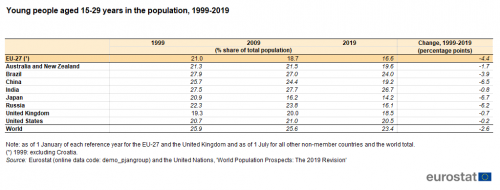
Source: Eurostat (demo_pjangroup) and the United Nations, 'World Population Prospects: The 2019 Revision'
The relative share of children and young people in the EU-27’s population was considerably lower than in many of the industrialised and rapidly emerging economies presented in Tables 2 and 3. For example, in 2019 children accounted for 26.6 % of the total population in India, more than one fifth (21.0 %) of the total population in Brazil and close to one fifth (19.3%) of the total population of Australia and New Zealand combined. There was, however, one exception: the relative share (12.6 %) of children in the Japanese population was lower than the EU-27 share, a situation also observed in 1999 and 2009.
Signs that the fall in birth and fertility rates is happening in other developed and emerging economies
Worldwide, there was a general decline in the relative share of children in the global population between 1999 and 2019. Their share decreased by 4.9 percentage points, which was a much larger decline than in the EU-27 (-2.0 points). The largest decreases (among those countries shown in Table 2) were observed in Brazil, India and China, where the share of children in the total population fell by 9.5, 8.5 and 7.7 points during the 20-year period under consideration. Russia and the United Kingdom were the only countries (among those shown in Table 2) where the share of children in the total population fell by less than the decline observed in the EU-27; the rate of decline in Australia and New Zealand combined was identical to that recorded for the EU-27.
The global share of young people in the world’s population declined by 2.6 percentage points over the period 1999-2019. The share of young people remained relatively stable in several of the countries shown in Table 3, while the share in Japan, China and Russia fell at a faster pace than it did in the EU-27 (down 4.4 points). Japan and Russia were the only countries shown in Table 3 to record shares of young people in their total populations (14.2 % and 16.1 %) in 2019 that were lower than the EU-27 share (16.6 %). By contrast, young people accounted for more than one quarter (26.7 %) of the total population in India.
The information presented in Tables 2 and 3 confirms that the pattern of decreasing birth and fertility rates observed across the EU-27 and Japan appears to be establishing itself across a range of other industrialised and emerging economies. As in many cases this is a relatively new phenomena, the most rapid changes in population structure are initially apparent among the age groups for children, although in the coming years the smaller shares for children will gradually feed into smaller shares for young people too, as the effect of lower birth and fertility rates moves up through each national population pyramid.
Ireland: the most youthful EU Member State
Ireland was the most youthful Member State in the EU-27, as people aged 0-29 years accounted for nearly 4 out of every 10 inhabitants at the start of 2019 (39.0 %). At the other end of the spectrum, the share of children and young people in the total population was lowest in Italy (28.3 %).
Children accounted for more than one in five (20.5 %) of the Irish population in 2019 — the highest share among the EU Member States — while France (18.0 %) and Sweden (17.8 %) recorded the second and third highest shares. By contrast, children accounted for 13.2 % of the Italian population at the start of 2019, while they also represented a relatively small share of the population in Germany (13.6 %), Malta and Portugal (both 13.7 %).
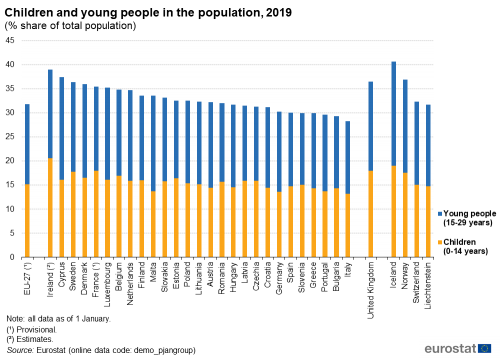
(% share of total population)
Source: Eurostat (demo_pjangroup)
The shares of young people in the populations of Bulgaria and Slovenia were 14.9 %, while there were also comparatively low shares in Italy (15.1 %) and Spain (15.2 %). Cyprus (21.3 %) recorded the highest proportion of young people in its population in 2019. Furthermore, children accounted for a much lower share of the total population in Cyprus than did young people (5.2 percentage points less) as was the case in Malta (6.2 points less), suggesting that Cypriot and Maltese birth and fertility rates had fallen rapidly over the last 15 years.
Children and young people accounted for a low share of the population in many eastern German, northern Spanish and Italian regions
While there was a considerable degree of variation in the share of children and young people between the EU Member States, the differences were even more pronounced across Europe’s regions. Among NUTS level 2 regions, Mayotte and Guyane (two French overseas departments) were the only regions in the EU-27 where children and young people represented more than half of the population in 2019, some 66.9 % and 55.7 % of their total number of inhabitants being aged 0-29 years. The fourth highest share was also recorded in a French overseas department, namely, La Réunion (41.9 %), while the Spanish autonomous city regions of Melilla (44.4 %) and Ceuta (40.0 %) had the third and sixth highest shares. Alongside these five regions from outside of continental Europe, the top 10 regions with the highest shares of children and young people included all three Irish regions and the Belgian and French capital regions. More generally, the regions which feature near the top of the ranking with the highest shares of children and young people in their respective populations were often from France, Ireland or Belgium.
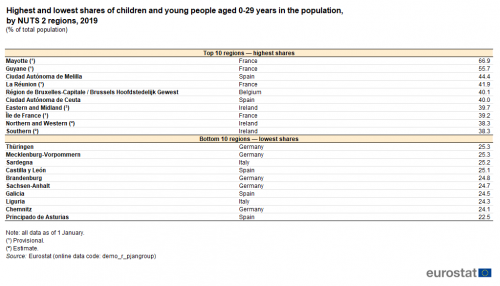
(% of total population)
Source: Eurostat (demo_r_pjangroup)
By contrast, the regions with the lowest shares of children and young people in their total number of inhabitants included the northern Spanish regions of Principado de Asturias, Galicia and Castilla y León, the eastern German regions of Chemnitz, Sachsen-Anhalt, Brandenburg, Mecklenburg-Vorpommern and Thüringen, and the Italian regions of Liguria and Sardegna. These regions were quite representative of a more general pattern, as many of the regions at the bottom end of the ranking were from eastern Germany, northern Spain and various parts of Italy, with children and young people often accounting for less than 27 % of the total population.
Outside of French overseas departments and Spanish autonomous cities, the three Irish regions had the highest shares of children in their populations
Map 1 presents the relative share of children in the regional populations of NUTS level 2 regions in 2019. Aside from the French overseas departments of Mayotte (43.8 %), Guyane (32.2 %) and La Réunion (22.5 %) and the Spanish Ciudades Autónomas de Melilla (23.7 %) y de Ceuta (20.4 %), the three regions of Ireland were the only other regions where the share of children in the total population stood at more than 20.0 %: Northern and Western (20.8 %), Eastern and Midland (20.6 %) and Southern (20.4 %).
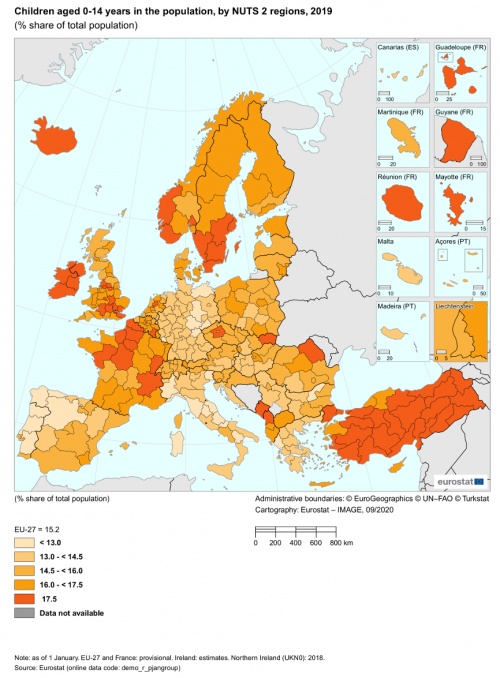
(% share of total population)
Source: Eurostat (demo_r_pjangroup)

(% share of total population)
Source: Eurostat (demo_r_pjangroup)
At the other end of the range, the Spanish region of Principado de Asturias recorded the lowest share of children (11.0 %). In line with the general patterns observed at a national level, some of the regions with the lowest shares of children in their total populations were located in Italy: for example, Liguria (11.1 %), Sardegna (11.2 %), Molise (11.3 %), Basilicata (11.9 %) and Friuli-Venezia Giulia (12.0 %). The only other regions in the EU where the share of children was no more than 12.0 % were the north-western Spanish regions of Galicia and Castilla y León (both 11.9 %)
Aside from the French overseas departments, Groningen in the Netherlands had the highest share of young people
Map 2 presents a similar set of information (to the previous map), but this time based on the share of young people in the regional population (again for NUTS level 2 regions). Aside from the French overseas departments of Guyane (23.4 %) and Mayotte (23.1 %), which are characterised by high birth rates, at the start of 2019 Groningen in the Netherlands had the highest share of young people (22.5 %) among regions of the EU. The high proportion of young adults living in this region may be linked to the relatively large numbers of students attending higher education institutions (some of whom may choose to stay in the region after graduation). There were six other regions across the EU where the share of young people in the total population was at least 20.0 %: the Belgian, Danish and Austrian capital regions, Midtjylland (Denmark), Ciudad Autónoma de Melilla (Spain) and Cyprus.
By contrast, the share of young people was particularly low in many of the same regions where the share of children was low, principally in northern Spain and eastern Germany as well as in Liguria (northern Italy). The lowest shares were recorded in the German regions of Chemnitz and Brandenburg (11.6 % and 11.7 %) and the Spanish region of Principado de Asturias (also 11.6 %).
The proportions of children and young people in the total population of the EU-27 are projected to fall more slowly in the coming decades
According to the main scenario of EUROPOP2019 — the latest round of Eurostat population projections — by 2080 the number of children and young people in the EU-27 is projected to be 121.2.0 million, which is 20.8 million less than in 2019. As the EU-27 total population is projected to keep growing through to 2026, reaching a peak of 449.3 million, the share of children and young people in the total population is projected to decrease from 31.8 % in 2019 to 28.6 % in 2052. From 2052, the share of children and young people is projected to increase marginally through until 2080 (without returning to anywhere near the current share).
EUROSTAT’S POPULATION PROJECTIONS
Population projections give a picture of what the future population may look like based on a set of assumptions for fertility and mortality rates as well as for migration.
EUROPOP2019 is a set of population projections produced by Eurostat based on the cohort-component method. These are essentially ‘what-if’ scenarios, providing information about the likely future size and structure of the population at national level, by sex and single-years of age. EUROPOP 2019 covered the time period from 1 January 2019 to 1 January 2100.
The projections presented in this article relate to what is referred to as the ‘baseline projection’, based on a set of assumptions relating to future fertility, mortality and net international migration. This baseline projection is complemented by other projections with different assumptions, such as lower fertility or mortality, or no, lower or higher migration.
Figure 3 shows the share of children and young people in the projected population of the EU-27 up to and including the year 2080. Having already fallen from 19.6 % in 1990 to 15.2 % by 2019, the share of children is projected to decrease further to a relative low of 13.6 % by 2039, after which there is projected to be little or no change (shares of 13.6 % or 13.7 %) up until 2074, followed by a slight increase to 13.9 % by 2080.
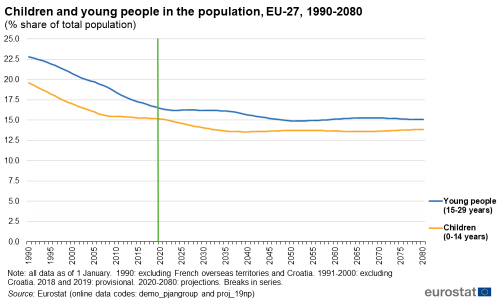
(% share of total population)
Source: Eurostat (demo_pjangroup) and (proj_19np)
The projected development of the share of young people in the EU-27’s total population also shows an initial decline followed by a period of relative stability until 2080. From 22.8 % of the total EU-27 population in 1990, the share of young people aged 15-29 years fell to 16.6 % by 2019 and is projected to decrease to a low of 14.9 % of the total population in 2052. The share of young people is subsequently projected to increase slightly to reach a peak of 15.3 % by 2067, before contracting again slightly to stand at 15.1 % in 2080.
Changes in numbers of children and young people: causes and consequences
Median age — the greying of the EU’s population
Ageing is one of the EU’s main demographic challenges which may result in considerable political, economic, budgetary and social challenges. The median age of the EU-27 population has risen in recent years as a direct consequence of two principal factors: a reduction in the share of children and young people in the total population (resulting from lower fertility rates and women giving birth to fewer children at a later age in life) and a gradual increase in life expectancy that has led to increased longevity.
HOW TO DETERMINE IF A POPULATION IS AGEING?
The ageing, or greying, of the EU’s population can be measured by looking at the median age of its population. The median age of the population is the age that divides a population into two numerically equal groups; that is, with half the people younger and half older. In other words, if all of the people in the EU-27 were ranked according to their age, the person standing in the middle of the line dividing those into two equal groups would have the median age.
The median age of the EU-27 population rose, on average, by three to four months each year over the last two decades
The median age of the EU-27 population was 43.7 years in 2019, having risen at a relatively rapid and consistent pace from 35.2 years in 1990 (data for this earlier reference period exclude Croatia), as shown in Figure 4. Eurostat’s latest population projections indicate further increases in the median age during the coming decades, initially at a slightly slower rate and thereafter at a much slower rate than the last few decades. The median age of 45.0 years is projected to be passed by 2025, 46.0 years by 2030, 47.0 years by 2035 and by 2043 the median age is projected to reach 48.0 years. The median age of the EU-27 population is projected thereafter to remain relatively unchanged, within the range of 48.0-48.8 years throughout the period 2043 to 2080.

(years)
Source: Eurostat (demo_pjanind) and (proj_19ndbi)
Nationally, the median age of the EU Member States in 2019 was lowest in the relatively youthful societies of Ireland and Cyprus (both 37.7 years), while Luxembourg and Malta were the only other EU Member States to record median ages of 40.0 years or less. By contrast, there was a more rapid greying of the population in Italy, where the median age was 46.7 years in 2019, while Germany (46.0 years) and Portugal (45.2 years) were the only other EU Member States to record median ages that were over 45.0 years.
The median age of the population within each EU Member State rose between 1990 and 2019. This ageing of the population was particularly stark in Lithuania, Portugal and Spain, as the median age rose in each of these Member States by more than 10.0 years during the period under consideration. There were increases of 9.0-10.0 years in Slovenia (note there is a break in series), Romania, Italy and Slovakia. By contrast, the median age of the population rose in Sweden and Luxembourg (note there is a break in series) at a relatively slow pace, up by 2.1 and 3.2 years respectively between 1990 and 2019 — see Figure 5.
Life expectancy — people are living longer
As noted above, greater longevity is one of the principal reasons why there has been an increase in the median age of the EU-27 population. Between 2002 and 2018 there was an increase of 3.4 years in life expectancy at birth (see Figure 6). The life expectancy of men increased at a somewhat faster pace than that of women, rising by 3.9 years compared with an increase of 2.8 years for women. These increases in life expectancy may be attributed to a range of factors, including medical progress and different types of health and community/social care, a general increase in health education/awareness, or people making different lifestyle choices, for example, stopping (or not starting) smoking, reducing alcohol intake, paying more attention to their diet, or exercising more [2]. Furthermore, there has also been a gradual change in workplace occupations, whereby fewer people (in particular men) are employed in labour-intensive or dangerous activities, for example, agriculture, mining or heavy manufacturing industries. Other changes in society may also be a factor, such as increased road safety.
Life expectancy steadily rising in the EU
The EU’s future population size and age structures will, to some degree, be determined by the pace at which life expectancy continues to increase (if recent trends prevail). While higher levels of life expectancy and increased longevity result in a higher median age across the population, at the other end of the age spectrum the fertility rate has the potential to provide a counterbalance to the on-going ageing process — this is studied in more detail in the next section.
Fertility rates — less children are being born
MEASURING FERTILITY
The total fertility rate represents the number of children that would be born to a woman if she were to live to the end of her childbearing years and bear children in accordance with the current age-specific fertility rates.
Age-specific fertility rates are computed as the ratio of the number of live births from women of a given age to the number of women of the same age exposed to childbearing (usually estimated as the average number of women in that year).
The replacement level represents the average number of live births per woman that would keep the population level stable and its age structure unchanged (in the absence of migratory flows or any change in life expectancy). It is generally agreed that the replacement level is about 2.1 children per woman in developed world economies.
Figure 7 shows that while fertility rates in the EU-27 rose at a modest pace during the period 2002-2008, they remained well below the replacement level. Having peaked between 2008 and 2010 with an average number of children in the range of 1.56-1.57, the fertility rate subsequently fell by a small amount, perhaps reflecting economic hardships and a decline in real incomes in the period following the global financial and economic crisis. In 2013, the EU-27 fertility rate was down to 1.51 children before increasing to 1.57 children by 2016 and then subsequently falling again back to 1.55 children in 2018.
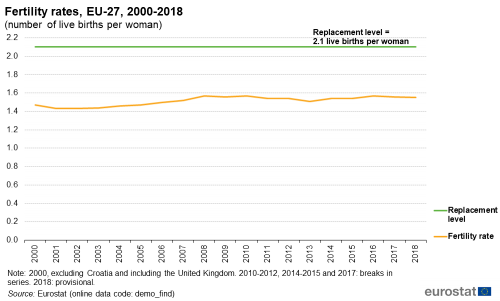
(number of live births per woman)
Source: Eurostat (demo_find)
France: the highest fertility rates
Among EU Member States, the highest fertility rate in 2018 was recorded in France, with an average of 1.88 live births per woman (during her lifetime). Figure 8 shows that there were also relatively high rates in Romania, Sweden (both 1.76 live births per woman) and Ireland (1.75 live births per woman). The lowest fertility rate in the EU was registered in Malta (1.23 live births per woman), while Spain and Italy were the only other Member States to record rates that were less than 1.30 live births per woman.
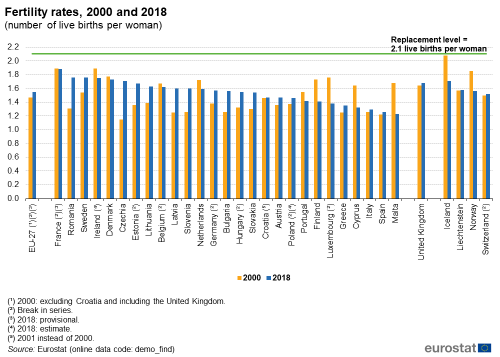
(number of live births per woman)
Source: Eurostat (demo_find)
Looking at women aged less than 30 years, their fertility rate in the EU-27 was 0.70 live births per woman in 2018, which was slightly less than half of the EU-27 total fertility rate that year (1.55 live births). This means that in the EU-27 just under half (46 %) of all babies were born to mothers who were below the age of 30.
Among EU Member States, Romania recorded the highest fertility rate for women aged less than 30 (with 1.10 live births per woman), followed by Bulgaria (0.99 live births per woman). By contrast, Cyprus, Luxembourg, Italy and Spain recorded the lowest fertility rates for women aged less than 30 (with fewer than 0.50 live births per woman).
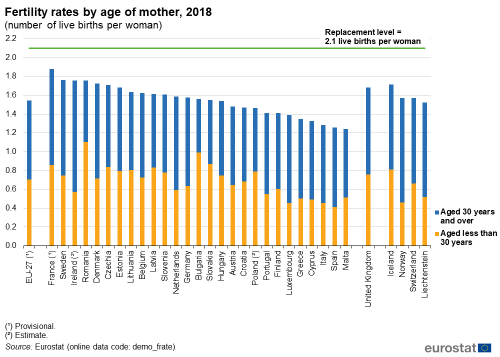
(number of live births per woman)
Source: Eurostat (demo_frate)
In Bulgaria and Romania, the fertility rate of women aged less than 30 corresponded to more than three fifths of the national fertility rate in 2018. By contrast, the fertility rate of women aged less than 30 represented less than one third of the national fertility rate in Ireland, Spain and Luxembourg, meaning that less than one third of babies in these countries were born to mothers aged less than 30.
The mean age of women giving birth to their first child was at least 30.0 years in the Netherlands, Greece, Ireland, Luxembourg, Spain and Italy in 2018
The mean age of women at the birth of their first child increased across all EU Member States in the last two decades. This can be explained, in particular, by a higher proportion of women continuing their studies into higher education, a larger proportion of women entering and remaining in the workforce, as well as changes in traditional family units (for example, less people getting married and people getting married later) [3].
Figure 10 provides information on the mean age of women at first childbirth. There were six EU Member States where the mean age of women at the birth of their first child in 2018 was at least 30.0 years: the Netherlands (30.0 years), Greece (30.4 years), Ireland (30.5 years), Luxembourg (30.9 years), Spain (31.0 years) and Italy (31.2 years). By contrast, the lowest mean ages for women at the birth of their first child were recorded in Romania (26.7 years) and Bulgaria (26.2 years).
The average age of women when giving birth to their first child rose in each of the EU Member States (for which data are available) on the basis of a comparison between 1998 and 2018. This pattern was particularly pronounced in Lithuania (4.2 years higher), Estonia and Cyprus (both 4.1 years higher), followed by Czechia (4.0 years), although it should be noted that there is a break in series for Estonia. By contrast, the pace of change was much slower in France (note there is a break in series) and the Netherlands, where the mean age of women at the birth of their first child rose by 1.0 and 1.3 years between 1998 and 2018.
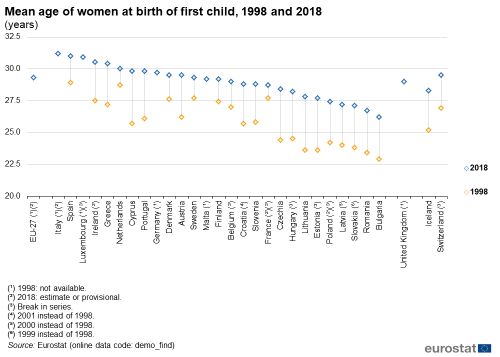
(years)
Source: Eurostat (demo_find)
Figure 11 shows that the EU Member States that had total fertility rates that were closest to the replacement level of 2.1 live births per woman displayed considerable variations in terms of the mean age at which women gave birth to their first child. In some Member States, the average age at which women gave birth was above the EU-27 average (for example, in Ireland or Denmark) whereas in others the average was lower (for example, in France or Romania).
The top right quadrant of Figure 11 identifies countries with above average fertility rates combined with an above average mean age of women at the birth of their first child. This quadrant is composed exclusively of Member States (and Norway) from northern and western Europe.
The bottom right quadrant of Figure 11 contains all of the southern EU Member States apart from Malta, as well as Austria and Luxembourg. These Member States and Switzerland were characterised by women giving birth to their first child at a relatively late age combined with relatively low fertility rates. Indeed, there appears to be some evidence to support the view that lower fertility rates can be expected in those Member States where women give birth (to their first child) later. Among the Member States, Italy, Spain and Luxembourg had the highest mean ages for women at the birth of their first child and all three of these recorded total fertility rates that were considerably below the EU-27 average, with Spain and Italy recording the second and third lowest rates.

Source: Eurostat (demo_find)
Dependency ratios — an increasing responsibility for those of working age
Age dependency ratios can be used when looking at the potential support that may be provided to children and to the elderly by people of working age. In 2019, the EU-27 young-age dependency ratio was 34.3 %, while the old-age dependency ratio was almost the same, at 34.1 %. This marks a turning point insofar as from 2020 onwards, the old-age dependency ratio is projected to be greater than the young-age dependency ratio, as the share of elderly people in the population rises in the EU-27, while the share of children continues to fall before stabilising (as presented above).
AGE DEPENDENCY RATIOS
The young-age dependency ratio is the ratio of persons aged 0-19 years divided by the number of persons considered to be of working age (defined here as those aged 20-64 years).
The old-age dependency ratio is the ratio of the number of persons conventionally considered to be economically inactive due to retirement (those aged 65 years and over) divided by the number of persons considered to be of working age (20-64 years).
The size of the working-age population in the EU-27 appears to have almost finished falling and this development will likely be completed once the baby-boom generation has completed its move into retirement in the next 10-15 years. As the number of children is projected to remain relatively unchanged, population projections suggest that the young-age dependency ratio will be relatively stable. By contrast, the number of elderly people (especially those aged 85 years and over) is projected to increase in the coming decades, such that they will account for a considerably larger share of the total population.
Figure 12 shows the development of age dependency ratios and their projected path from 1990 until 2080, and provides a clear picture of the challenges that lie ahead concerning how the projected working-age population will need to support the young and particularly the increasing number of elderly persons.
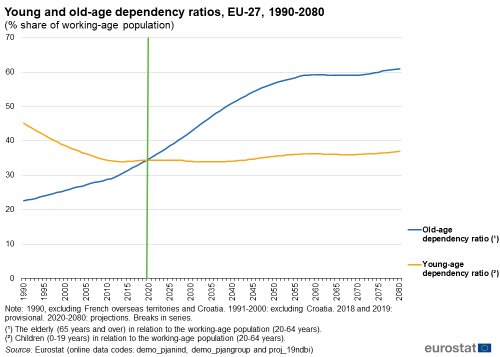
(% share of working-age population)
Source: Eurostat (demo_pjanind), (demo_pjangroup) and (proj_19ndbi)
Adding up the share of young and old-age people who will depend on the working-age population, today’s generation of children are projected to face an increased burden in relation to supporting the remainder of the population as they move into work. For example, maintaining welfare systems, pension schemes and public healthcare systems is likely to pose a challenge, while the overall demand for services from such systems and schemes is likely to increase, due to the rising number of elderly people. As such, policymakers are concerned about how to ensure the long-term sustainability of public finances in the face of a declining share of economically active people. One potential, partial solution to some of these issues is an increase in statutory retirement ages, while elderly people at risk of poverty or social exclusion may consider working later into life than is currently the norm.
Source data for tables and graphs
Data sources
The data presented in this article are principally drawn from Eurostat’s population statistics, and more specifically from a range of demography indicators at a national and regional level (providing information on the structure of populations), fertility measures, mortality patterns and population projections (EUROPOP2019).
In this article, children are generally considered as persons aged 0-14 years. Although there is no clear-cut definition of ‘youth’ or ‘young people’ since these terms are often used to describe the transitory phase between childhood and adult life, the EU’s youth strategy has confirmed that for statistical purposes the most useful definition is to cover persons aged 15-29 years; this definition has been employed for the majority of the information presented in this article. Demographic statistics have a wealth of information for these age groups, while they can also provide statistics at a more detailed level, for example, by five-year age groups (such as people aged 10-14 years or 15-19 years).
Eurostat carries out annual collections of demography data from national statistical authorities, including statistics concerning population and vital events, the latter including for example live births, deaths, marriages and divorces. These data are used to compute and disseminate demographic indicators at national and regional levels. Population data refer to the situation on 1 January of the reference year and are generally based on the usual resident population.
Context
The impact of demographic change in Europe
The EU frequently reviews and adapts its policies in relation to demographic challenges, such as the ageing population, relatively low birth and fertility rates, atypical family structures and migration.
The outbreak of the COVID-19 pandemic has forced changes globally and within the EU and will leave a lasting impact on the way we live and work together. The pandemic started at a time when the EU had already been going through a period of profound demographic and societal change. Indeed, the European Commission’s report on The impact of demographic change presents the main drivers of change and the impact this may have across the EU. It launched a process designed to help identify specific actions and solutions, mindful of lessons learned from the COVID-19 pandemic, to support people, regions and communities that are most affected and to enable them to adapt to changing (demographic) situations.
The report highlights five key issues where demographic changes are likely to have a considerable impact in the coming years:
- Europe’s working-age population is shrinking and the EU will therefore need to find ways to sustain economic growth by bringing more people into jobs and increasing productivity.
- Health and social care systems across Europe will need to adapt and consideration will need to be given as to how to fund higher age-related public spending.
- Demographic challenges often vary significantly between different parts of the same country. As some regions are likely to experience rapid population change, this will lead to new opportunities and challenges, from investment (including in infrastructure) to access to services.
- Demographic change may also impact Europe’s position in the world: the EU’s share of global population and GDP will likely continue to become smaller.
- Demographic changes as well as green and digital transitions often affect, support or accelerate each other: strategic planning will therefore be essential to prepare policies to address these issues.
The report was complemented by a set of country factsheets providing more detailed statistical information for the EU-27 and individual EU Member States.
Direct access to
- Population (demo_pop)
- Population on 1 January by age group and sex (demo_pjangroup)
- Fertility (demo_find)
- Fertility rates by age (demo_frate)
- Regional data (demopreg)
- Population on 1 January by age group, sex and NUTS 2 region (demo_r_pjangroup)
- Population on 1st January by age, sex and type of projection (proj_19np)
- Demographic balances and indicators by type of projection (proj_19ndbi)
- Population (demo_pop) (ESMS metadata file — demo_pop_esms)
- Demographic balance and crude rates at national level (demo_gind) (ESMS metadata file — demo_gind)
- Demographic balance and crude rates at regional level (demo_r_gind3) (ESMS metadata file — demo_r_gind3)
- Population projections (proj) (ESMS metadata file —proj_esms)
Notes
- ↑ The baby-boomer generation is a demographic phenomenon describing a period marked by considerably higher than average birth rates within a certain geographical area. The baby-boomer generation is often used to refer to people who were born post-World War II, between the years 1946 and 1970 in Europe and the United States.
- ↑ See Health at a glance 2019 and Sassi, F. (2010), Obesity and the Economics of Prevention — Fit not Fat, OECD Publishing, Paris.
- ↑ See Why do people postpone parenthood? Reasons and social policy incentives, Melinda Mills, Ronald R. Rindfuss, Peter McDonald, Egbert te Velde, 2011.

